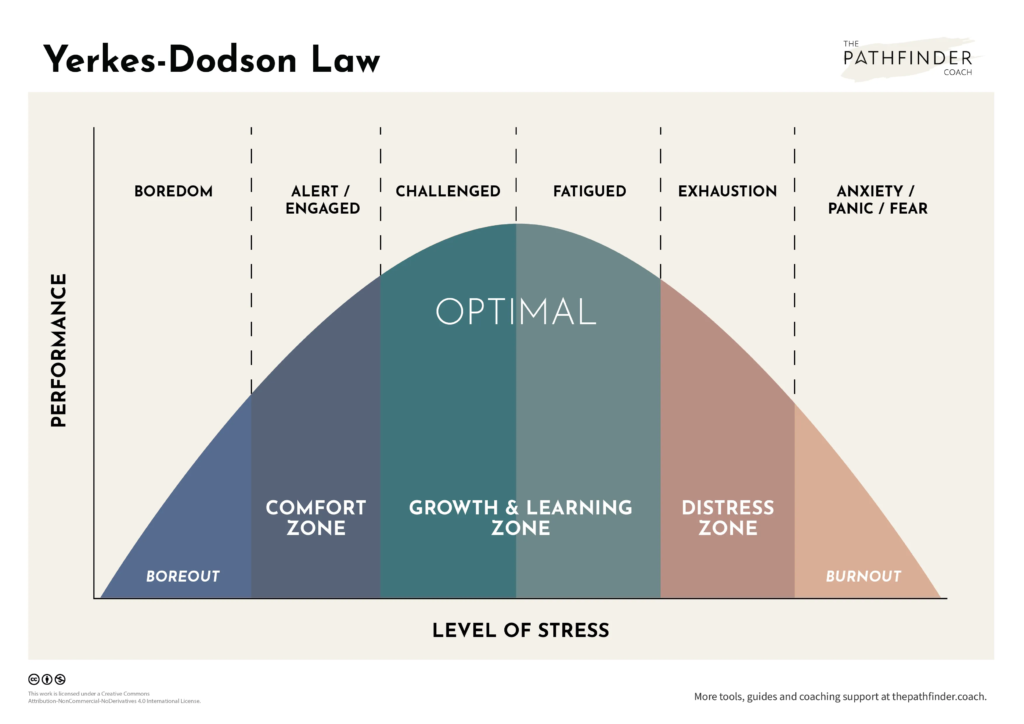The Yerkes-Dodson Law is a psychological theory that explores the relationship between arousal levels and performance. First formulated in 1908 by two psychologists, Robert Yerkes and John Dodson, this law suggests that an individual’s performance improves with increasing arousal levels up to a certain point, after which performance declines as arousal continues to rise. In essence, optimal performance is achieved at a moderate level of arousal—neither too low nor too high.
Low Arousal: Lack of Motivation and Stagnation

At low levels of arousal, individuals often struggle to stay motivated. This can lead to a lack of interest in tasks, distractions, and even boredom. For instance, an employee in a work environment may find their tasks monotonous and unchallenging, leading to low arousal levels and negatively impacting their performance. Low arousal is common in tasks that do not provide enough challenges, which prevents individuals from fully utilizing their abilities.
Normal Arousal: The Peak Performance Level
According to the Yerkes-Dodson Law, normal arousal levels represent the point at which individuals perform at their best. At this level, individuals are sufficiently motivated and focused on their tasks, allowing them to work most efficiently. This balance occurs when tasks are interesting and challenging enough to engage individuals. For example, an athlete during a competition may reach an appropriate level of stress, enabling them to channel their energy and skills effectively. At this level, individuals can fully showcase their abilities and maximize their potential.
High Arousal: Stress and Performance Decline
At high levels of arousal, individuals often experience excessive stress and anxiety. This can lead to distractions, impaired decision-making processes, and a general decline in performance. High arousal levels can negatively affect individuals, especially in situations that require intense focus or under pressure. For example, a student experiencing exam stress may not perform to their full potential, as high arousal levels hinder their ability to concentrate and recall information.
The Inverted U Model: The Balance Between Arousal and Performance
One of the most important concepts presented by the Yerkes-Dodson Law is the inverted U-shaped relationship between arousal and performance. This model shows that performance decreases when arousal levels are too low or too high, but optimal performance is achieved at a moderate level of arousal. This principle applies across many fields: sports, education, and the workplace, where individuals achieve the best results when they strike this balance.
For example, a project manager who effectively manages their team’s arousal levels can complete a project on time and successfully. However, if they apply too much pressure, it may increase stress levels and reduce productivity. Conversely, if too little pressure is applied, team members may not be sufficiently motivated and might not give the project the attention it requires.
The Cultural Context of Yerkes-Dodson Law
It is also important to consider how the Yerkes-Dodson Law operates within a cultural context. Responses to stress and arousal levels can vary across different cultures. For example, some cultures may perform better at higher arousal levels, while for others, this may create a stressful situation. This is particularly evident in work cultures and education systems. In Japanese work culture, high arousal levels are often the norm, and individuals adapt to this environment. However, such arousal levels may be overly stressful for individuals in Western societies, leading to a decline in performance.
Applying Yerkes-Dodson Law in Everyday Life
The Yerkes-Dodson Law offers many practical lessons for everyday life. In work and educational settings, managing arousal levels correctly can help individuals fully utilize their potential. An adequate amount of challenge and stress can increase motivation, while excessive stress can have a negative impact on performance. Therefore, it is important for individuals to recognize their own arousal levels and adjust accordingly.
For instance, if a student realizes they are overly stressed while preparing for exams, they can reduce this stress by practicing breathing exercises or slowing down their study pace. Similarly, a manager can enhance their employees’ performance by balancing their arousal levels, preventing them from becoming overly stressed while keeping their motivation high.
Finding the Balance

The Yerkes-Dodson Law is a valuable tool for understanding the complex relationship between arousal levels and performance. Knowing how low, normal, and high arousal levels affect performance can help individuals and managers develop more effective strategies. Ultimately, finding the right balance is crucial for both individual and organizational success. The inverted U model visually represents this balance, helping individuals and teams identify the optimal arousal level for peak performance. Achieving this balance enhances both individual and societal well-being.


